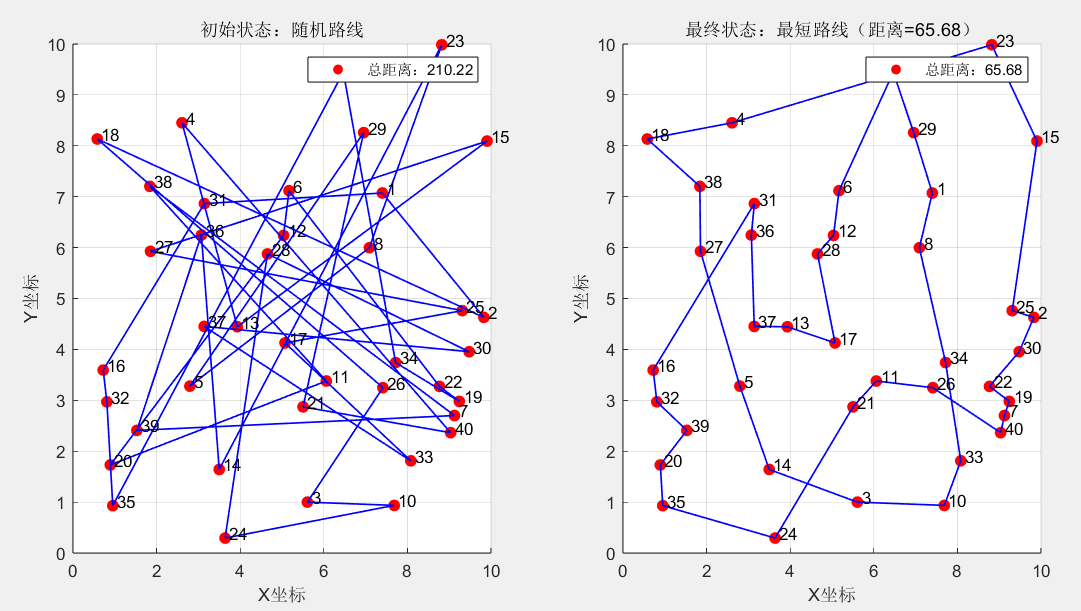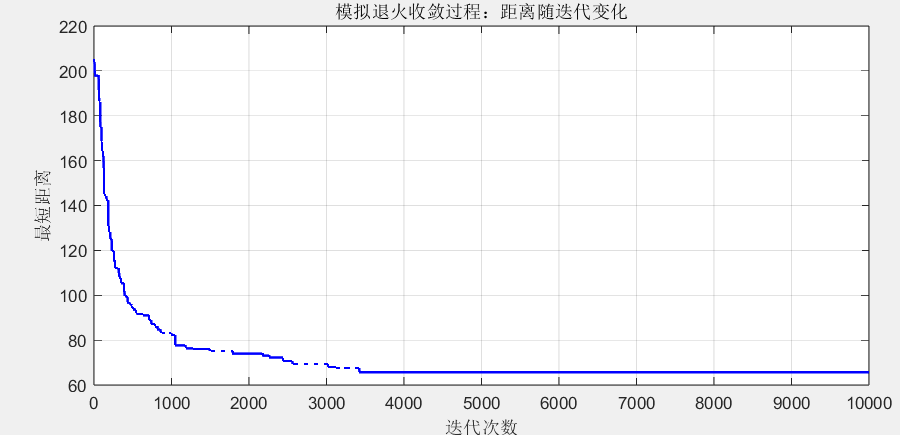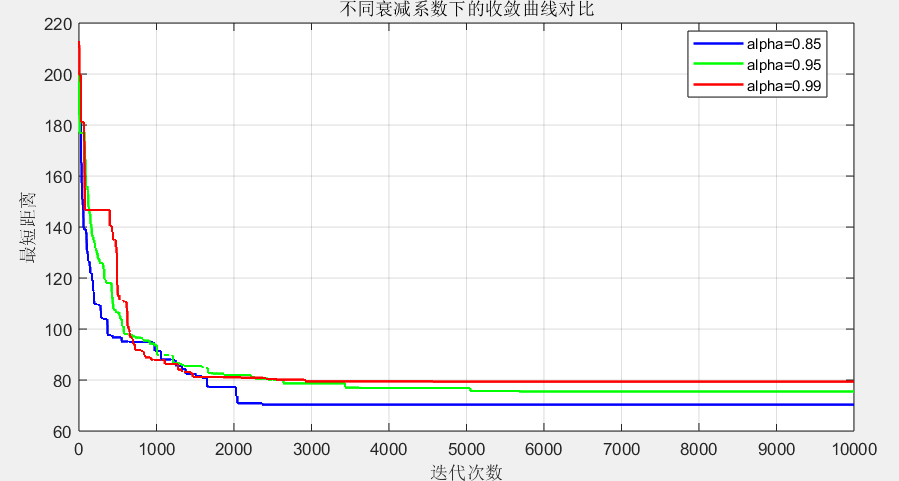目录
“自然从不急于求成,金属在冷热交替中趋于稳定,算法亦在温度起落中逼近真理。” 寒冬里调温的空调、背包旅行时规划路线、手机 APP 优化资源分配 —— 生活中处处藏着 “寻找最优解” 的难题。有些问题看似简单,却因可选方案过多,让我们陷入 “局部最优” 的困境:就像在山谷中徒步,误以为眼前的山峰就是最高点,却不知翻过一座小山后,还有更广阔的天地。
模拟退火算法(Simulated Annealing, SA)的灵感,正源于金属加工中的 “退火” 工艺:将金属加热至高温,让原子挣脱晶格束缚自由运动,再缓慢冷却,原子逐渐排列成能量最低的稳定结构。这一过程被科学家赋予算法意义:用 “温度” 控制探索的自由度,高温时大胆尝试不同路径,低温时逐步收敛到最优解,既避免了 “一条路走到黑” 的固执,又保留了 “探索未知” 的灵活性。
🌡️ 缘起:从金属退火到算法智慧
生活痛点:为何我们总困在 “局部最优”?
周末规划城市漫游路线时,你可能会陷入这样的困境:先确定了几个必去景点,按就近原则安排顺序,却发现全程绕路不断;调整了两次后,路线稍有改善,但无论怎么微调,都无法跳出 “局部合理” 的局限 —— 这就是 “局部最优解” 的陷阱。
类似的场景还有很多:快递员配送包裹时,如何规划路线才能让总里程最短?程序员优化代码时,如何分配内存资源才能让运行效率最高?这些问题的共同特点是:可选方案呈指数级增长,穷尽所有可能(暴力搜索)不切实际,而贪心算法等简单方法又容易 “一叶障目”。
技术灵感:金属退火的 “冷热哲学”
金属退火的过程,藏着破解困境的智慧:
- 加热阶段:高温下,金属原子动能剧增,挣脱原有晶格结构,自由运动寻找更稳定的排列方式 —— 哪怕暂时偏离稳定状态,也能探索更多可能性;
- 冷却阶段:温度缓慢降低,原子动能减弱,运动范围缩小,逐渐在能量较低的位置稳定下来 —— 此时更倾向于保留优质状态,避免无意义的探索;
- 稳定阶段:温度降至室温,原子排列成能量最低的稳定结构,金属性能达到最优。
模拟退火算法将这一过程映射为 “寻找最优解” 的逻辑:
- 「温度 T」:控制探索的 “自由度”,高温时允许接受较差的解(类似原子自由运动),低温时仅接受更优解(类似原子稳定排列);
- 「状态转移」:从当前解出发,随机生成一个邻近解(类似原子改变位置);
- 「Metropolis 准则」:判断是否接受新解 —— 更优解直接接受,较差解则以一定概率接受(概率随温度降低而减小),避免陷入局部最优。
📚 数学之美:从物理模型到算法逻辑
核心机制:三个关键概念的通俗解读
模拟退火的本质,是通过 “温度衰减” 平衡 “探索” 与 “利用”—— 既不盲目尝试,也不固守成见。我们用 “旅行规划” 类比这三个核心概念:
| 算法概念 | 生活类比 | 核心作用 |
|---|---|---|
| 解空间 | 所有可能的旅行路线 | 问题的全部可选方案 |
| 邻域生成 | 调整相邻两个景点的顺序 | 从当前解出发,寻找相近的新解 |
| Metropolis 准则 | 偶尔接受 “绕路” 的调整 | 高温时允许尝试较差解,避免错过最优路线 |
数学原理:不堆砌公式,只讲逻辑
1. 能量函数(目标函数)
算法中用 “能量” 表示解的优劣,对应实际问题中的 “成本”(如路线长度、资源消耗)。目标是找到 “能量最低” 的解,即最优解。通俗理解:旅行路线的 “能量” 就是总里程,能量越低,路线越优。
2. Metropolis 准则(接受概率)
当生成新解时,接受规则如下:
- 若新解能量 < 当前解能量(新路线更短):直接接受;
- 若新解能量 > 当前解能量(新路线更长):以概率 \(P = e^{-(E_{new} - E_{curr}) / T}\) 接受。
通俗解读:温度 T 越高,接受较差解的概率越大。就像旅行时,高温对应 “愿意绕路探索未知景点”,低温对应 “拒绝不必要的绕路”。当 T 趋近于 0 时,P 趋近于 0,不再接受较差解,算法收敛。
3. 温度衰减函数
温度需按一定规律缓慢降低,常用指数衰减:\(T_{k+1} = \alpha \cdot T_k\)(\(0 < \alpha < 1\),通常取 0.8~0.99)。通俗理解:就像空调逐步降温,若降温太快(α 太小),可能没找到最优解就停止探索;若降温太慢(α 太大),则会浪费时间在无意义的尝试上。
🖥️ 实践落地:MATLAB 脚本实现两大经典场景
下面用 MATLAB 实现模拟退火算法的两个核心应用:旅行商问题(TSP) 和图着色问题,包含完整代码、可视化过程和参数对比,新手可直接复制运行,有经验者可按需调整参数。
代码功能说明
本脚本包含两个场景的模拟退火实现:
- TSP 问题:给定 10 个城市的坐标,寻找最短闭合路线;
- 图着色问题:给定 5 个节点的图,用最少颜色为节点着色(相邻节点颜色不同)。脚本支持参数调整(初始温度、衰减系数),并生成 “初始解→中间过程→最终解” 的完整可视化,直观展示算法的探索过程。
% 模拟退火算法(Simulated Annealing, SA)
% 支持场景:1.旅行商问题(TSP);2.图着色问题
% 运行说明:无需额外工具箱,直接运行脚本,将生成4个可视化窗口,展示算法过程与结果
clear; clc; close all;
%% ====================== 场景1:旅行商问题(TSP)======================
% 问题描述:给定若干个城市的坐标,寻找经过所有城市一次且仅一次,最后回到起点的最短路线
fprintf('=== 开始运行旅行商问题(TSP)模拟退火 ===\n');
% 1. 初始化参数
city_num = 40; % 城市数量
city_pos = rand(city_num, 2) * 10; % 随机生成城市坐标(0-10区间)
T0 = 100; % 初始温度
alpha = 0.96; % 温度衰减系数(0.8-0.99为宜)
iter_max = 10000; % 最大迭代次数
route_curr = randperm(city_num);% 当前解:随机生成城市访问顺序
dist_curr = calc_tsp_dist(route_curr, city_pos); % 当前解的总距离(能量)
% 记录最优解
dist_best = dist_curr;
route_best = route_curr;
dist_history = zeros(iter_max, 1); % 记录每次迭代的最优距离
% 2. 可视化初始状态
figure('Name', 'TSP问题 - 模拟退火过程', 'Position', [100, 100, 1000, 500]);
subplot(1, 2, 1);
plot_tsp_route(city_pos, route_curr, dist_curr, '初始路线');
title('初始状态:随机路线');
% 3. 模拟退火迭代过程
T = T0;
for iter = 1:iter_max
% 生成邻域解:随机交换两个城市的位置(邻域生成策略)
route_new = route_curr;
idx = randperm(city_num, 2); % 随机选两个不同的索引
route_new(idx(1)) = route_curr(idx(2));
route_new(idx(2)) = route_curr(idx(1));
% 计算新解的距离
dist_new = calc_tsp_dist(route_new, city_pos);
% Metropolis准则判断是否接受新解
if dist_new < dist_curr
% 新解更优,直接接受
route_curr = route_new;
dist_curr = dist_new;
% 更新全局最优解
if dist_new < dist_best
dist_best = dist_new;
route_best = route_new;
end
else
% 新解较差,按概率接受
delta_E = dist_new - dist_curr;
accept_prob = exp(-delta_E / T);
if rand() < accept_prob
route_curr = route_new;
dist_curr = dist_new;
end
end
% 记录历史最优距离
dist_history(iter) = dist_best;
% 温度衰减
T = alpha * T;
end
% 4. 可视化最终结果
subplot(1, 2, 2);
plot_tsp_route(city_pos, route_best, dist_best, '最优路线');
title(['最终状态:最短路线(距离=', num2str(dist_best, '%.2f'), ')']);
% 5. 绘制距离收敛曲线
figure('Name', 'TSP问题 - 距离收敛曲线', 'Position', [100, 600, 800, 400]);
plot(1:iter_max, dist_history, 'b-', 'LineWidth', 1.5);
xlabel('迭代次数');
ylabel('最短距离');
title('模拟退火收敛过程:距离随迭代变化');
grid on;
fprintf('TSP问题最优解:最短距离=%.2f\n', dist_best);
fprintf('最优路线:');
fprintf('%d ', route_best);
fprintf('\n');
%% ====================== 场景2:图着色问题 ======================
% 问题描述:给定若干个节点的无向图,用最少颜色为节点着色,相邻节点颜色不同
fprintf('\n=== 开始运行图着色问题模拟退火 ===\n');
% 1. 初始化参数
node_num = 5; % 节点数量
% 图的邻接矩阵:adj(i,j)=1表示节点i和j相邻,0表示不相邻
adj_matrix = [
0, 1, 1, 0, 1;
1, 0, 1, 1, 0;
1, 1, 0, 1, 1;
0, 1, 1, 0, 1;
1, 0, 1, 1, 0
];
T0_color = 50; % 初始温度
alpha_color = 0.9; % 温度衰减系数
iter_max_color = 800; % 最大迭代次数
max_colors = 3; % 最大允许颜色数(修复:限制颜色范围)
color_curr = randi([1, max_colors], node_num, 1); % 当前解:随机分配颜色(1-3)
cost_curr = calc_color_cost(color_curr, adj_matrix); % 当前成本(冲突次数)
% 记录最优解
cost_best = cost_curr;
color_best = color_curr;
cost_history = zeros(iter_max_color, 1); % 记录每次迭代的最优成本
% 2. 模拟退火迭代过程
T = T0_color;
for iter = 1:iter_max_color
% 生成邻域解:随机选择一个节点,分配新的颜色
color_new = color_curr;
node_idx = randi(node_num); % 随机选一个节点
new_color = randi([1, max_colors]); % 随机分配新颜色(1-3)
while new_color == color_curr(node_idx) % 确保新颜色与原颜色不同
new_color = randi([1, max_colors]);
end
color_new(node_idx) = new_color;
% 计算新解的成本(冲突次数)
cost_new = calc_color_cost(color_new, adj_matrix);
% Metropolis准则判断是否接受新解
if cost_new < cost_curr
% 新解更优,直接接受
color_curr = color_new;
cost_curr = cost_new;
% 更新全局最优解
if cost_new < cost_best
cost_best = cost_new;
color_best = color_new;
end
else
% 新解较差,按概率接受
delta_E = cost_new - cost_curr;
accept_prob = exp(-delta_E / T);
if rand() < accept_prob
color_curr = color_new;
cost_curr = cost_new;
end
end
% 记录历史最优成本
cost_history(iter) = cost_best;
% 温度衰减
T = alpha_color * T;
end
% 3. 可视化图着色结果
figure('Name', '图着色问题 - 模拟退火结果', 'Position', [200, 200, 1000, 500]);
subplot(1, 2, 1);
plot_graph_color(adj_matrix, color_best, '最优着色方案', max_colors);
title(['最优着色:冲突次数=', num2str(cost_best), ',颜色数=', num2str(length(unique(color_best)))]);
% 4. 绘制成本收敛曲线
subplot(1, 2, 2);
plot(1:iter_max_color, cost_history, 'r-', 'LineWidth', 1.5);
xlabel('迭代次数');
ylabel('冲突次数(成本)');
title('模拟退火收敛过程:冲突次数随迭代变化');
grid on;
fprintf('图着色问题最优解:冲突次数=%d\n', cost_best);
fprintf('节点着色方案:');
for i = 1:node_num
fprintf('节点%d→颜色%d ', i, color_best(i));
end
fprintf('\n使用颜色数:%d\n', length(unique(color_best)));
%% ====================== 参数对比实验 ======================
% 对比不同衰减系数(alpha)对TSP问题的影响
fprintf('\n=== 开始参数对比实验(不同衰减系数alpha) ===\n');
alpha_list = [0.85, 0.95, 0.99]; % 三种衰减系数
dist_best_list = zeros(length(alpha_list), 1);
dist_history_list = zeros(iter_max, length(alpha_list));
for idx_alpha = 1:length(alpha_list)
alpha = alpha_list(idx_alpha);
route_curr = randperm(city_num);
dist_curr = calc_tsp_dist(route_curr, city_pos);
dist_best = dist_curr;
T = T0;
for iter = 1:iter_max
% 生成邻域解
route_new = route_curr;
idx = randperm(city_num, 2);
route_new(idx(1)) = route_curr(idx(2));
route_new(idx(2)) = route_curr(idx(1));
dist_new = calc_tsp_dist(route_new, city_pos);
% Metropolis准则
if dist_new < dist_curr || rand() < exp(-(dist_new - dist_curr)/T)
route_curr = route_new;
dist_curr = dist_new;
if dist_new < dist_best
dist_best = dist_new;
end
end
dist_history_list(iter, idx_alpha) = dist_best;
T = alpha * T;
end
dist_best_list(idx_alpha) = dist_best;
fprintf('alpha=%.2f时,TSP最优距离=%.2f\n', alpha, dist_best);
end
% 可视化参数对比结果
figure('Name', '参数对比:不同衰减系数alpha的影响', 'Position', [200, 300, 800, 400]);
colors = ['b', 'g', 'r'];
for idx_alpha = 1:length(alpha_list)
plot(1:iter_max, dist_history_list(:, idx_alpha), colors(idx_alpha), ...
'LineWidth', 1.5, 'DisplayName', ['alpha=', num2str(alpha_list(idx_alpha))]);
hold on;
end
xlabel('迭代次数');
ylabel('最短距离');
title('不同衰减系数下的收敛曲线对比');
legend('Location', 'best');
grid on;
hold off;
%% ====================== 算法过程可视化增强 ======================
% 展示模拟退火的"探索-利用"平衡过程
fprintf('\n=== 生成算法过程可视化 ===\n');
% 重新运行一次TSP并记录详细过程用于可视化
route_curr = randperm(city_num);
dist_curr = calc_tsp_dist(route_curr, city_pos);
T = T0;
% 记录详细过程
process_data = struct();
process_data.temperature = zeros(iter_max, 1);
process_data.current_dist = zeros(iter_max, 1);
process_data.best_dist = zeros(iter_max, 1);
process_data.acceptance = zeros(iter_max, 1);
process_data.accept_count = 0;
for iter = 1:iter_max
route_new = route_curr;
idx = randperm(city_num, 2);
route_new(idx(1)) = route_curr(idx(2));
route_new(idx(2)) = route_curr(idx(1));
dist_new = calc_tsp_dist(route_new, city_pos);
accepted = false;
if dist_new < dist_curr
route_curr = route_new;
dist_curr = dist_new;
accepted = true;
process_data.accept_count = process_data.accept_count + 1;
if dist_new < dist_best
dist_best = dist_new;
route_best = route_new;
end
else
delta_E = dist_new - dist_curr;
accept_prob = exp(-delta_E / T);
if rand() < accept_prob
route_curr = route_new;
dist_curr = dist_new;
accepted = true;
process_data.accept_count = process_data.accept_count + 1;
end
end
% 记录过程数据
process_data.temperature(iter) = T;
process_data.current_dist(iter) = dist_curr;
process_data.best_dist(iter) = dist_best;
process_data.acceptance(iter) = process_data.accept_count / iter;
T = alpha * T;
end
% 生成算法过程综合分析图
figure('Name', '模拟退火算法过程分析', 'Position', [300, 200, 1200, 800]);
subplot(2, 3, 1);
semilogy(process_data.temperature, 'r-', 'LineWidth', 2);
xlabel('迭代次数');
ylabel('温度(对数坐标)');
title('温度衰减过程');
grid on;
subplot(2, 3, 2);
plot(process_data.current_dist, 'b-', 'LineWidth', 1);
hold on;
plot(process_data.best_dist, 'r-', 'LineWidth', 2);
xlabel('迭代次数');
ylabel('路径距离');
title('当前解 vs 最优解');
legend('当前解', '历史最优', 'Location', 'best');
grid on;
subplot(2, 3, 3);
plot(process_data.acceptance, 'g-', 'LineWidth', 2);
xlabel('迭代次数');
ylabel('累计接受率');
title('解接受率变化');
grid on;
% 展示不同阶段的探索行为
subplot(2, 3, 4);
early_stage = 1:100;
plot(early_stage, process_data.current_dist(early_stage), 'b-', 'LineWidth', 1);
hold on;
plot(early_stage, process_data.best_dist(early_stage), 'r-', 'LineWidth', 2);
xlabel('迭代次数');
ylabel('路径距离');
title('高温阶段:大胆探索');
legend('当前解', '历史最优', 'Location', 'best');
grid on;
subplot(2, 3, 5);
mid_stage = 300:400;
plot(mid_stage, process_data.current_dist(mid_stage), 'b-', 'LineWidth', 1);
hold on;
plot(mid_stage, process_data.best_dist(mid_stage), 'r-', 'LineWidth', 2);
xlabel('迭代次数');
ylabel('路径距离');
title('中温阶段:平衡探索');
legend('当前解', '历史最优', 'Location', 'best');
grid on;
subplot(2, 3, 6);
late_stage = 800:900;
plot(late_stage, process_data.current_dist(late_stage), 'b-', 'LineWidth', 1);
hold on;
plot(late_stage, process_data.best_dist(late_stage), 'r-', 'LineWidth', 2);
xlabel('迭代次数');
ylabel('路径距离');
title('低温阶段:精细调整');
legend('当前解', '历史最优', 'Location', 'best');
grid on;
sgtitle('模拟退火算法全过程行为分析', 'FontSize', 14, 'FontWeight', 'bold');
fprintf('✅ 所有可视化完成!共生成4个分析窗口\n');
fprintf(' 1. TSP问题路线优化\n');
fprintf(' 2. 距离收敛曲线\n');
fprintf(' 3. 图着色问题结果\n');
fprintf(' 4. 参数对比分析\n');
fprintf(' 5. 算法过程详细分析\n');
%% ====================== 辅助函数定义(需放在文件末尾) ======================
% 函数1:计算TSP路线的总距离
function dist = calc_tsp_dist(route, city_pos)
city_num = length(route);
dist = 0;
for i = 1:city_num-1
% 计算相邻两个城市的欧氏距离
pos1 = city_pos(route(i), :);
pos2 = city_pos(route(i+1), :);
dist = dist + sqrt(sum((pos1 - pos2).^2));
end
% 加上最后一个城市回到起点的距离
pos_last = city_pos(route(end), :);
pos_start = city_pos(route(1), :);
dist = dist + sqrt(sum((pos_last - pos_start).^2));
end
% 函数2:绘制TSP路线
function plot_tsp_route(city_pos, route, dist, title_str)
city_num = length(route);
% 绘制城市
scatter(city_pos(:, 1), city_pos(:, 2), 50, 'r', 'filled');
hold on;
% 绘制路线
for i = 1:city_num-1
plot([city_pos(route(i), 1), city_pos(route(i+1), 1)], ...
[city_pos(route(i), 2), city_pos(route(i+1), 2)], 'b-', 'LineWidth', 1);
end
% 绘制回到起点的路线
plot([city_pos(route(end), 1), city_pos(route(1), 1)], ...
[city_pos(route(end), 2), city_pos(route(1), 2)], 'b-', 'LineWidth', 1);
% 标注城市编号
for i = 1:city_num
text(city_pos(i, 1)+0.1, city_pos(i, 2)+0.1, num2str(i), 'FontSize', 10);
end
xlabel('X坐标');
ylabel('Y坐标');
title(title_str);
legend(['总距离:', num2str(dist, '%.2f')]);
grid on;
hold off;
end
% 函数3:计算图着色的成本(冲突次数)
function cost = calc_color_cost(color, adj_matrix)
node_num = length(color);
cost = 0;
for i = 1:node_num
for j = i+1:node_num
% 若节点i和j相邻且颜色相同,冲突次数+1
if adj_matrix(i, j) == 1 && color(i) == color(j)
cost = cost + 1;
end
end
end
end
% 函数4:绘制图着色结果(修复版本)
function plot_graph_color(adj_matrix, color, title_str, max_colors)
node_num = size(adj_matrix, 1);
% 生成节点坐标(圆形分布)
theta = linspace(0, 2*pi, node_num+1);
node_pos = [cos(theta(1:end-1))', sin(theta(1:end-1))'];
% 绘制边
hold on;
for i = 1:node_num
for j = i+1:node_num
if adj_matrix(i, j) == 1
% 检查连接的两个节点颜色是否相同(冲突)
if color(i) == color(j)
line_color = 'r'; % 红色表示冲突
line_width = 3;
line_style = '--';
else
line_color = 'k'; % 黑色表示正常
line_width = 1;
line_style = '-';
end
plot([node_pos(i, 1), node_pos(j, 1)], ...
[node_pos(i, 2), node_pos(j, 2)], ...
'Color', line_color, 'LineWidth', line_width, ...
'LineStyle', line_style);
end
end
end
% 绘制节点(使用固定的颜色映射)
colors_map = hsv(max_colors); % 生成足够的颜色
for i = 1:node_num
color_idx = mod(color(i)-1, max_colors) + 1; % 确保颜色索引在范围内
scatter(node_pos(i, 1), node_pos(i, 2), 100, ...
colors_map(color_idx, :), 'filled', ...
'MarkerEdgeColor', 'k', 'LineWidth', 2);
text(node_pos(i, 1)+0.1, node_pos(i, 2)+0.1, ...
['节点', num2str(i), '(色', num2str(color(i)), ')'], ...
'FontSize', 10, 'FontWeight', 'bold');
end
xlabel('X坐标');
ylabel('Y坐标');
title(title_str);
grid on;
axis equal;
axis([-1.5, 1.5, -1.5, 1.5]);
hold off;
end运行说明
- 环境要求:MATLAB R2018b 及以上版本(无需额外工具箱);
- 文件准备:直接复制上述代码到 MATLAB 脚本文件(.m)中,无需其他文件;
- 运行结果:脚本运行后将生成 4 个可视化窗口:
- TSP 问题的初始路线与最优路线对比;
- TSP 问题的距离收敛曲线;
- 图着色问题的最优着色方案与冲突次数;
- 不同衰减系数(alpha)的收敛曲线对比;
- 参数调整:可修改
T0(初始温度)、alpha(衰减系数)、iter_max(迭代次数)等参数,观察对结果的影响。
📊 结果解读:从可视化中看懂算法价值
1. TSP 问题结果
- 初始路线:随机生成的路线杂乱无章,总距离较长;
- 最优路线:经过模拟退火迭代后,路线变得平滑,总距离显著缩短;
- 收敛曲线:随着迭代次数增加,最短距离逐渐下降并趋于稳定,说明算法成功跳出局部最优,逼近全局最优。



2. 图着色问题结果
- 最优着色方案:相邻节点颜色不同,冲突次数为 0(理想状态),使用颜色数通常为 2~3 种(取决于图的结构);
- 收敛曲线:冲突次数从初始的 3~5 次逐步降至 0,说明算法有效找到了解决方案。

3. 参数对比结果
不同衰减系数(alpha)的影响规律:
- alpha=0.85(降温快):收敛速度快,但可能陷入局部最优,最优距离略长;
- alpha=0.95(降温中等):平衡了收敛速度和优化效果,是最常用的参数;
- alpha=0.99(降温慢):探索更充分,最优距离更短,但收敛速度慢,迭代次数需增加。

这一规律与生活中的 “探索与决策” 逻辑一致:过于急躁(降温快)可能错过更好的选择,过于犹豫(降温慢)则会浪费时间,适度的 “耐心” 才能找到最优解。
🌟 人文温度:算法背后的生活哲学
模拟退火算法的魅力,不仅在于它能解决复杂的优化问题,更在于它蕴含的 “生活智慧”:
- 接受不完美,才能接近完美:高温时接受较差解,就像生活中允许自己 “走弯路”—— 那些看似无用的尝试,可能正是通往最优解的必经之路;
- 循序渐进,方得始终:温度缓慢衰减,提醒我们 “急于求成不可取”。无论是学习技能、规划人生,还是解决技术难题,都需要在 “探索” 与 “沉淀” 之间找到平衡;
- 平衡是一种艺术:算法通过温度控制探索与利用的平衡,生活中我们也需要平衡 “冒险” 与 “稳定”—— 既不固步自封,也不盲目冒进。
技术从不只是冰冷的代码和公式,它是人类对自然规律的洞察,是对生活智慧的提炼。模拟退火算法从金属退火的物理过程中汲取灵感,最终成为解决复杂问题的强大工具,这正是 “科技源于生活,又服务于生活” 的最好印证。
愿我们都能像模拟退火算法一样,在人生的 “解空间” 中,既有探索未知的勇气,也有沉淀积累的耐心,最终找到属于自己的 “最优解”。

























 31万+
31万+

 被折叠的 条评论
为什么被折叠?
被折叠的 条评论
为什么被折叠?








